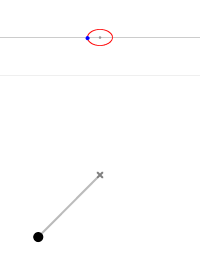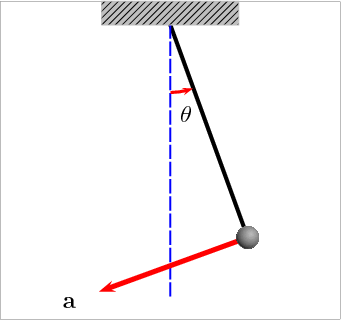Jacobi amplitude function appeared yesterday in the episode Derivatives of Jacobi elliptic am, sn, cn, dn. We have derived a beautiful simple differential equation satisfied by this beautiful function
Today we will see that, after rescaling, this is a perfect fabric for making the nonlinear outfit for the mathematical pendulum.
Wikipedia has smart animations showing pendulum’s motion for different kinetic energies, for instance

Initial angle of 45°

Pendulum with enough energy for a full swing.
It has also another little animation showing the angle ![]() avrying with time.
avrying with time.

But this last picture is not well adapted for a pendulum that is making full swings around the circle. Therefore I will refer to the picture that I was already using in The case of the swinging pendulum:

This last picture has many more features depicted than I will need. I will need only the angles ![]() and
and ![]() and the length of the pendulum
and the length of the pendulum ![]() . The mass of the swinging point P I will denote by
. The mass of the swinging point P I will denote by ![]() . Usually it is denoted by
. Usually it is denoted by ![]() but we will use
but we will use ![]() for the square of the modulus
for the square of the modulus ![]() of the Jacobi amplitude function
of the Jacobi amplitude function ![]()
For solving our pendulum problem we will only need conservation of energy.
When the pendulum swings, the angle ![]() changes with time
changes with time ![]() We will use the dot to denote time derivative of
We will use the dot to denote time derivative of ![]()
![]()
The linear velocity ![]() of the pendulum is
of the pendulum is ![]() , therefore the kinetic energy
, therefore the kinetic energy ![]() is
is
![]()
For the potential energy we will choose the zero of the potential at the bottom, Denoting by ![]() the height of the mass with respect to the lowest level, we have
the height of the mass with respect to the lowest level, we have
![]()
For ![]() we have
we have ![]() for
for ![]() we have
we have ![]() Here it is useful to introduce the half-angle
Here it is useful to introduce the half-angle ![]() We know from trigonometry that
We know from trigonometry that
![]()
Therefore
(2) ![]()
Potential energy ![]() is
is ![]() that is
that is
(3) ![]()
Maximum kinetic energy ![]() is at the bottom, for
is at the bottom, for ![]() . At this point we have also minimum potential energy, since
. At this point we have also minimum potential energy, since ![]() at the point. Maximal potential energy
at the point. Maximal potential energy ![]() is at the top:
is at the top: ![]()
The character of the motion will depend on the ratio ![]() When this ratio is
When this ratio is ![]() there will be not enough kinetic energy to rise the swinging mass to the top, and the pendulum will oscillate back and forth. But when the ratio
there will be not enough kinetic energy to rise the swinging mass to the top, and the pendulum will oscillate back and forth. But when the ratio ![]() then
then
even at the top the mass will have a nonzero speed, and the pendulum will be making full circles. We denote this important ratio by ![]()
![]()
Thus
(4) ![]()
We now write the conservation of energy equation:
![]()
On the left we have total energy at time ![]() On the right we have total energy at the bottom, when there is only kinetic energy. Substituting the
On the right we have total energy at the bottom, when there is only kinetic energy. Substituting the ![]() with the corresponding expressions derived above we get
with the corresponding expressions derived above we get
(5) ![]()
Now, ![]() therefore
therefore ![]()
We also introduce ![]() defined as
defined as
(6) ![]()
This is the expression for the standard angular frequency for a linear pendulum, fo small oscillations.
With all these substitutions and simplifications Eq. (5) can be written in the following form:
(7) ![]()
The last equation is almost identical with the equation (1) satisfied by the amplitude function, except for the coefficient ![]() in front of
in front of ![]() on the left. But this can be easily accomodated by changing the time scale. With
on the left. But this can be easily accomodated by changing the time scale. With ![]() we notice that
we notice that
![]()
Comparing with Eq. (7) we see that the solution of the pendulum equation is
(8) ![]()
and therefore
(9) ![]()
.
In the next post we will look closer at this solution and try to understand its meaning.




.
I hope copy and paste of Latex works. I tried doing it this way. Solving Angular acceleration =-K sin(Theta)
{\frac {{\rm d}^{2}}{{\rm d}{t}^{2}}}\Theta \left( t \right) =-{\omega
_{{o}}}^{2}\sin \left( \Theta \left( t \right) \right)
and the solution maple gave was
\int ^{\Theta \left( t \right) }\!{\frac {1}{\sqrt {2\,{\omega_{{0}}}^
{2}\cos \left( {\it \_a} \right) +{\it \_C1}}}}{d{\it \_a}}-t-{\it
\_C2}=0
This seems to be along the lines of Jacobi functions. How would I transform this?
Erratum
In (5) m should be in denominator
In (7a) k and t reversed
In (7a) and (8) and (9) am has only one argument
@Bjab – Thanks for the erratum. Fixed.
@Ronan – You can make latex to work in comments if you start your comment with “latexpage” in square braces, like here

Detailed instructions here
And yes, the formula for the solution given by Maple can be converted into the formula from my post. The constant C2 is for shifting the zero of time (I have it set to 0). The constant C1 relates to m.
{\omega_{{0}}}^{2}={\frac {g}{l}}
\int ^{\Theta \left( t \right) }\!{\frac {1}{\sqrt {2\,{\omega_{{0}}}^
{2}\cos \left( \Theta \right) +{\it \_C1}}}}{d\Theta}-t-{\it \_C2}=0
I did type letexpage in the square brackets. I tested these on http://quicklatex,com and they rendered.I am using internet explorer on win 7.I don’t really see been able to type a meaningful formula in latex.